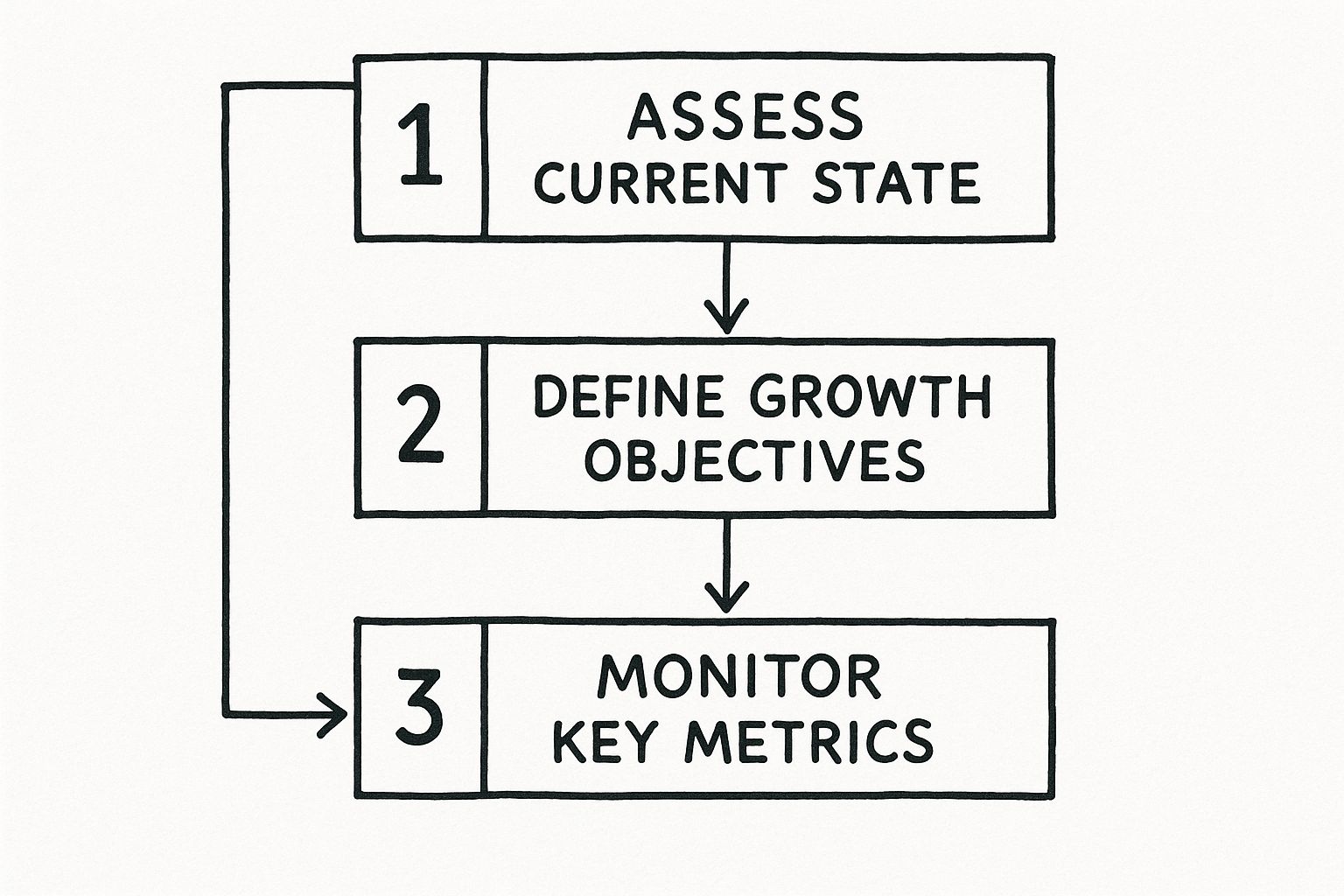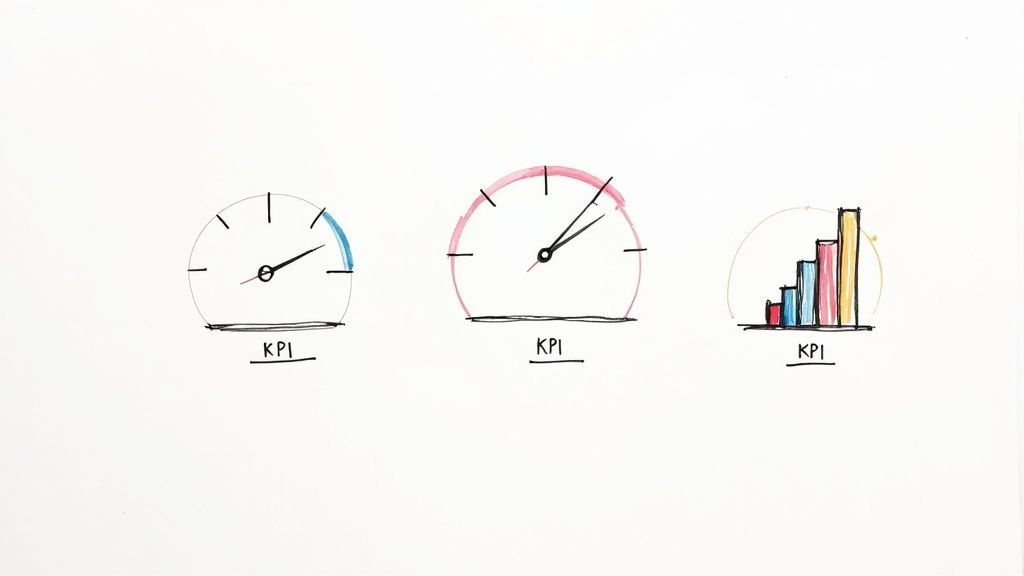Table of Contents
Why Most Growth Strategies Fail (And What Actually Works)
Building a Framework That Adapts
Building Your Framework for Growth Foundation
Essential Components of an Effective Growth System
The Art of Strategic Prioritization in Growth
Evaluating Opportunities and Making Tough Choices
Balancing Urgent Needs and Strategic Investments
Communicating Choices and Maintaining Team Confidence
Creating Feedback Systems That Drive Real Results
Designing Monitoring Approaches for Actionable Insights
Synthesizing Feedback From Multiple Sources
Creating Review Cycles That Change Behavior
Practical Tips for Effective Feedback Systems
Scaling Without Losing What Made You Successful
Maintaining Framework Integrity During Rapid Expansion
Training and Empowering Your Team
Recognizing the Need for Evolution
Navigating Setbacks and Strengthening Your Framework
Identifying and Diagnosing Problems
Responding Effectively Under Pressure
Adapting Your Framework vs. Trusting the Process
Learning From Setbacks and Emerging Stronger
Your Framework for Growth Implementation Plan
Phase 1: Laying the Groundwork
Phase 2: Building Your Framework
Why Most Growth Strategies Fail (And What Actually Works)

Let's be real, how often do those picture-perfect "growth frameworks" actually work? Not often in my experience. I've worked with a lot of software leaders, and the stories I hear are surprisingly similar. Those fancy strategies, often lifted from big-name consulting firms, often end up forgotten.
Why? Because they miss the point of how real growth happens.
One major mistake is thinking the market stays the same. These frameworks often ignore unexpected competition, sudden market shifts, or, you know, a global pandemic. They see growth as this straight line upwards, predictable and easy. But real growth is messy. It's unpredictable. It's more like hiking a winding trail than cruising down a highway. Understanding these pitfalls is crucial. For a deeper dive, check out these proven SaaS growth strategies.
This isn't about pointing fingers, it's about accepting that things rarely go exactly as planned. Look at the global economy – even that isn't growing like it used to. The United Nations projects growth at 2.8% in 2025, the same as 2024, and still below the pre-pandemic average of 3.2%. Weak investments, slow productivity, and high debt are all factors. You can find more on this here. This just highlights how important it is to be adaptable.
Building a Framework That Adapts
So, what does work? The successful growth frameworks I've seen all have these things in common:
Flexibility: They bend, not break. Think of bamboo in a hurricane – it yields to the wind but rarely snaps.
Focus: They pick a few key areas instead of trying to do everything at once. Trying to do too much at once just leads to average results.
Feedback: They use constant feedback to adjust and change course in real-time. It's all about learning and adapting as you go.
Ownership: They give teams the power to own their growth initiatives. Growth isn't a top-down order, it's something everyone contributes to.
For more on this topic, you might find this interesting: Read also: Growth
From Theory to Practice
These ideas might sound abstract, but they lead to real actions. Imagine a software company entering a new market. A rigid framework might lay out a specific marketing campaign, a fixed budget, and set milestones. But what if the market doesn't react as predicted? What if a competitor shows up with something completely new?
A flexible framework, on the other hand, lets you change things up. Maybe you shift the marketing message, move some budget around, or even rethink the target market.
This flexible approach isn't about ditching the plan entirely. It's about being willing to change when you need to. It's about being okay with uncertainty and even using it to your advantage. It's about making your framework a living thing that changes and grows along with your business. That's the kind of framework that actually works in today's world.
Building Your Framework for Growth Foundation
Forget one-size-fits-all solutions. Let's build a growth framework that actually works for your specific software business. In my experience working with digital leaders, a solid foundation is the key differentiator between companies that flourish and those that merely survive. We'll explore how to create this foundation, drawing on real-world examples and practical advice.
This begins with a crystal-clear understanding of your current position, your desired future, and how you'll measure progress. The infographic below visualizes this foundational process:

As the infographic illustrates, assessing your current state, defining clear growth objectives, and consistently monitoring key metrics are the bedrock of any successful growth strategy. This creates a cycle of continuous improvement and adaptation.
Essential Components of an Effective Growth System
Every successful growth framework requires a few vital ingredients. It's not about checking off items on a list, but about building a system that actively fuels growth.
Meaningful feedback loops: Don't just gather data – actually use it. I've witnessed companies drowning in data, unable to extract actionable insights. Turn data into decisions.
Predictive metrics: Focus on what's likely to happen, not just what's already happened. Leading indicators offer valuable foresight into market shifts, customer behavior, and emerging trends. Forget vanity metrics. They won’t help you predict the future.
Honest assessment: Identify your weaknesses before they become major liabilities. This requires self-awareness, but it's far simpler (and less costly) to address problems early on. Think of it as preventative maintenance for your business.
Before we dive deeper, let’s look at the core differences between traditional and more adaptable growth frameworks. The table below highlights the essential components and their implementation challenges.
| Framework Component | Traditional Approach | Adaptive Approach | Implementation Difficulty |
|---|---|---|---|
| Planning Cycle | Annual/Static | Continuous/Iterative | Moderate |
| Metrics Focus | Lagging Indicators (Past Performance) | Leading Indicators (Future Performance) | High |
| Response to Change | Slow/Reactive | Fast/Proactive | High |
| Data Utilization | Reporting/Monitoring | Analysis/Decision-Making | High |
| Team Structure | Siloed | Cross-functional | Moderate |
As you can see, while adaptive approaches offer significant advantages in responding to market dynamics, they also present a greater challenge to implement effectively.
Assessing Your Current State
Before crafting a successful growth framework, you need a clear understanding of your starting point. This involves a realistic evaluation of your strengths, weaknesses, opportunities, and threats. A SWOT analysis can be incredibly valuable here. Consider your internal capabilities and external influences.
For example, a software company might have a talented engineering team (strength) but a limited marketing budget (weakness). A growing market for their product presents an opportunity, while increasing competition poses a threat.
Defining Growth Objectives
Once you understand your current situation, you can define clear, measurable, achievable, relevant, and time-bound (SMART) growth objectives. What do you want to accomplish? How will you measure success? Specific, quantifiable goals dramatically improve focus and accountability.
Instead of a vague goal like "increase market share," aim for something concrete, like "increase market share by 10% in the next 12 months." This provides a clear target and timeframe.
Monitoring Key Metrics
With your goals established, you need a system for tracking progress. This involves identifying key metrics that align with your growth objectives. These will vary depending on your business model and goals, but common examples include customer acquisition cost (CAC), customer lifetime value (CLTV), and monthly recurring revenue (MRR). Tools like Google Analytics can be incredibly useful for tracking these metrics.
Regularly monitoring these metrics reveals what's working, what's not, and where adjustments are needed. It's an ongoing process, not a one-time exercise. This continuous adaptation is what distinguishes thriving businesses from those that stagnate. Treat your growth framework as a living document, adapting to the constantly evolving market. A rigid framework is a brittle framework. You need a system that can bend without breaking, adapting to both challenges and opportunities as they arise. This adaptability is the key to sustained, long-term growth.
The Art of Strategic Prioritization in Growth
The difference between a flourishing growth framework and one that fizzles out often comes down to prioritization. It's like tending a garden: the best soil and tools won't help if you plant everything at once and neglect the seedlings with the most potential. Experienced leaders get this. They know how to sequence growth initiatives for a compounding effect, avoiding scattered efforts.
Evaluating Opportunities and Making Tough Choices
With limited resources, picking the right battles is crucial. I've witnessed countless software companies spread themselves thin chasing every new, exciting opportunity instead of focusing on what truly matters. The result? Burnout, diluted resources, and ironically, slower growth.
One practical technique is the Impact/Effort Matrix. Plot potential initiatives on a grid based on their potential impact and the effort required. Tack high-impact, low-effort initiatives first. These quick wins build momentum and free up resources for more challenging, high-impact projects down the line.
Another critical aspect is aligning choices with your overall growth framework. Does an opportunity truly contribute to your long-term goals, or is it a distraction? Urgent demands can easily sidetrack us, but successful leaders learn to distinguish between what's truly important and what's merely urgent.
Balancing Urgent Needs and Strategic Investments
The tension between urgent needs and strategic investments is a constant challenge. It's like balancing a budget: you need to pay your bills (urgent needs) but also invest in your future (strategic investments). A growth framework helps find this balance.
For example, imagine a software company facing a sudden, user-impacting bug. Addressing this bug is urgent, but it shouldn't derail long-term strategic initiatives, like developing a new product feature. Effective leaders allocate resources to address both, ensuring short-term stability while investing in future growth.
Recent projections illustrate the need for a robust framework. Global growth is expected to slow from 3.3% in 2024 to 2.9% in 2025 and 2026, impacted by trade policy uncertainty and tighter financial conditions, according to the OECD. This highlights the importance of strategic prioritization to navigate economic headwinds.
Communicating Choices and Maintaining Team Confidence
Even with a perfect plan, expect some resistance. Teams naturally have competing priorities. Transparent communication and building consensus are key. A well-defined decision-making framework, like the Impact/Effort Matrix, helps justify choices and maintain team confidence when progress seems slow.
Strong communication is also crucial with stakeholder pressure. Stakeholders often have their own agendas, which may not align with your strategic priorities. Learn to clearly and confidently explain your rationale, while remaining open to feedback. This fosters trust and keeps everyone focused on the bigger picture.
You might be interested in this: Check out our guide on: Technical Leadership Skills. These skills are essential for conveying complex decisions and building alignment within your team. Ultimately, strategic prioritization means making informed choices that maximize your chances of success, focusing your energy on the initiatives that truly matter, and creating a compounding effect that drives sustainable growth.
Creating Feedback Systems That Drive Real Results

Most growth frameworks fall flat because they're disconnected from the constantly shifting market. The secret sauce? Building robust feedback systems. Think of them as your early warning radar, catching issues before they become disasters and highlighting what's working before your competitors catch on.
Designing Monitoring Approaches for Actionable Insights
The point isn't to hoard data; it's to turn it into actionable insights. I've seen teams practically drown in data, completely stuck in analysis paralysis. The real skill is designing monitoring systems that give you clear signals without overwhelming your team. This means being laser-focused on the few metrics that truly move the needle. More data isn't the answer; the right data is.
For example, ditch the dozens of vanity metrics and zero in on leading indicators. These are the metrics that predict future performance, like customer engagement scores, trial-to-paid conversion rates, and net promoter scores. These tell you where you're going, not just where you've been. Also, consider setting clear action thresholds for each metric. This combats analysis paralysis by giving you pre-defined triggers for specific actions. When a metric crosses that threshold, boom – a pre-determined response kicks in automatically.
Synthesizing Feedback From Multiple Sources
Feedback should be coming at you from all angles: customers, your team, the market, and your internal data. Each source offers a unique perspective, and combining these perspectives gives you the full picture. This means actively seeking feedback, creating open channels for it to flow, and truly listening.
One practical approach? Regular feedback sessions with key stakeholders. Make them structured, focused, and designed to uncover actionable insights. Remember though, not all feedback is equal. Learn to separate the signal from the noise. Look for patterns and trends, not just one-off anecdotes.
Creating Review Cycles That Change Behavior
Review cycles shouldn’t just be about reports; they should drive real change. This means building a culture of accountability where feedback leads to concrete actions that you can track and measure. It's not about pointing fingers, it's about learning from mistakes and constantly getting better.
After-Action Reviews (AARs) are a powerful tool here. After a project wraps up, bring the team together to discuss what went well, what could be improved, and what lessons you can take forward. This fosters a culture of continuous learning. Don't forget to address conflicting viewpoints and stay objective, especially when things get tough. Honest self-assessment is essential for growth, even when it’s uncomfortable.
Before we dive into some practical tips, let's look at some key metrics you can use to measure the effectiveness of your feedback systems. The following table outlines some core performance indicators to keep an eye on.
Growth Framework Feedback Metrics
| Metric Type | Measurement Method | Review Frequency | Action Threshold |
|---|---|---|---|
| Customer Satisfaction (CSAT) | Surveys, feedback forms | Monthly | Score below 7/10 |
| Net Promoter Score (NPS) | Surveys | Quarterly | Score below 70 |
| Trial-to-Paid Conversion Rate | Internal data tracking | Weekly | Conversion rate below 5% |
| Customer Churn Rate | Internal data tracking | Monthly | Churn rate above 2% |
| Employee Satisfaction | Internal surveys | Bi-Annually | Score below 4/5 |
This table provides a starting point. The specific metrics and thresholds you choose will depend on your individual context and goals. The important thing is to actively track these metrics and adjust your approach as needed.
Practical Tips for Effective Feedback Systems
Here are a few nuggets of wisdom I've picked up over the years:
- Keep it simple: Focus on a few key metrics. Don't drown your team in data.
- Make it actionable: Your feedback systems should produce clear, actionable insights.
- Be consistent: Regularly review your metrics and make adjustments.
- Be open: Encourage feedback from everyone and foster open communication.
- Be objective: Separate emotions from the data and make data-driven decisions.
By creating strong feedback systems, you can transform your growth framework from a static document into a dynamic, evolving system that adapts to the ever-changing market. This allows you to spot opportunities, tackle challenges, and ultimately, achieve sustainable growth.
Scaling Without Losing What Made You Successful
Growth is exciting. More customers, more revenue, more impact – who wouldn't want that? But here's the thing: growth can quickly introduce a lot of complexity, and that complexity can choke the life out of a perfectly good growth framework. I've witnessed this firsthand. A company finds its rhythm, its initial growth strategy is humming along, and then…bam. Rapid expansion throws everything out of whack. That once nimble, effective framework suddenly becomes a slow, bureaucratic mess.
Maintaining Framework Integrity During Rapid Expansion
So, how do you scale without losing the secret sauce that got you here? It's all about adapting your framework while staying true to its core principles. Think of it like adding on to your house. You begin with a solid foundation, but as you expand, you need to reinforce that foundation to support the added weight.
One major pitfall to avoid is over-complicating things. I worked with a software company that, during a period of rapid growth, implemented this incredibly complicated, multi-layered reporting system for their growth framework. It was so cumbersome that teams spent more time filling out reports than actually doing the work to drive growth. They ultimately ditched the entire system and went back to a simpler, more agile approach.
To scale effectively, you really need to keep your ear to the ground and understand your customers. Analyzing customer feedback is critical. This allows you to pinpoint areas for improvement and tailor your framework to meet their evolving needs.
Another critical factor is maintaining open communication. As your team grows, ensuring everyone is on the same page gets much harder. Regularly communicate the core principles of your framework, explain why it’s important, and encourage feedback from everyone, at every level. This builds shared understanding and helps prevent silos. It's interesting to note that global growth has been impacted by changing investment patterns and policy uncertainties since the early 2000s. From 6% annual growth in developing economies in the 2000s, we saw a dip to about 5% in the 2010s, and further down to below 4% in the 2020s. This highlights the importance of a solid and flexible framework for navigating global economic shifts. You can find more on this here.
Training and Empowering Your Team
Scaling well also hinges on your team understanding and buying into your growth framework. This isn’t about enforcing a rigid set of rules. It’s about giving your team the tools and knowledge to use the framework to their advantage. In my experience, workshops and training sessions are incredibly valuable. Provide practical examples, case studies, and hands-on practice opportunities. This helps team members internalize the framework and apply it effectively.
Furthermore, cultivate a culture of ownership. Encourage team members to take responsibility for their growth initiatives and empower them to make decisions within the framework. This fosters a sense of shared purpose and boosts overall engagement.
Recognizing the Need for Evolution
Finally, keep in mind that no growth framework is static. As your company changes, your framework should too. Regularly evaluate its effectiveness, identify areas for improvement, and be willing to adjust as needed. This doesn't mean abandoning your core principles – it means adapting them to new challenges and opportunities.
It’s important to differentiate between when your framework actually needs to evolve and when you simply need better execution. Sometimes, the framework isn’t the problem – it’s how it’s being used. Before you overhaul your framework, assess whether the issue is with the framework itself or its implementation.
By concentrating on these key areas – maintaining integrity, training your team, and embracing evolution – you can scale your growth approach effectively. You’ll maintain the agility and focus that made it successful in the first place, creating a sustainable system for growth that adapts to the ever-changing landscape of your business.
Navigating Setbacks and Strengthening Your Framework

This screenshot from Wikipedia's Strategic Management page really highlights how strategic planning is a continuous loop. You're constantly analyzing, putting plans into action, and then evaluating the results – kind of like steering a ship. It's crucial for any growth framework, and it underscores how important adapting to change is. No plan survives contact with the real world perfectly intact.
Building a framework for growth isn't about never facing setbacks; it's about knowing how to deal with them. Trust me, even with the best planning, curveballs will come your way. How you respond to these challenges is often what determines your framework's success.
Identifying and Diagnosing Problems
The first thing is recognizing when something's off. This takes honest reflection and a willingness to face tough questions. Are your key metrics falling behind? Is the team’s energy low? Has the market taken an unexpected turn? Figuring out the root cause of these problems is key. Don’t just blame outside forces; look inward at your own processes.
For example, imagine a software company notices a drop in user engagement. Instead of pointing fingers at competitors, they should examine internal factors. Maybe a recent product update or a change in customer support is the real culprit. Focusing internally often reveals the best insights.
Responding Effectively Under Pressure
When problems arise, it’s natural to feel pressured to act quickly, but that can lead to hasty decisions. Seasoned leaders take a more strategic approach. They gather data, talk to their teams, and weigh their options before making a move.
This doesn't mean doing nothing. It means choosing wisely, not reacting impulsively. Think about the long-term effects of your decisions and avoid quick fixes that create bigger problems down the road. Thinking about scaling? This article has some solid ideas: grow B2B SaaS.
Adapting Your Framework vs. Trusting the Process
One of the hardest calls you’ll make is knowing when to adjust your framework and when to stick to the plan. Sometimes, small tweaks are enough. Other times, you need a major strategy shift. This decision hinges on your long-term goals and what’s actually causing the setback.
Let’s say a marketing campaign is underperforming. A simple message tweak might do the trick. But if the target market has changed, you probably need a bigger strategic shift. This article might be helpful: Learn more in our article about: The Value of Coaching and Leadership Development for Growth.
Learning From Setbacks and Emerging Stronger
Every setback is a chance to learn and grow. By honestly evaluating what went wrong, you can identify weak spots in your framework and make it stronger. This process of learning and adapting is crucial for building a resilient growth framework. It's not about never making mistakes, but about using them to your advantage.
Companies that embrace this mindset come out stronger and more adaptable. They see setbacks not as failures, but as valuable lessons that refine their approach and contribute to long-term success. This ability to learn and adapt is what separates the truly successful companies from the rest.
Your Framework for Growth Implementation Plan
Alright, let's get practical. We've talked about why growth strategies sometimes fall flat and what really fuels lasting growth. Now, let's turn those ideas into action. This isn't about randomly trying things and hoping for the best. It's a focused, step-by-step approach to avoid getting overwhelmed and killing good ideas before they even get started.
Phase 1: Laying the Groundwork
Think of this phase like planning a road trip. You need a destination and a route before you hit the gas. Here, we're figuring out where you are now and where you want to go.
Assess Your Current Landscape: A good old SWOT analysis is key here. What are your company's strengths and weaknesses? What opportunities are out there, and what threats could get in your way? Honesty is crucial.
Define SMART Goals: "Get more customers" is too vague. SMART goals – Specific, Measurable, Achievable, Relevant, and Time-Bound – are your friend. Think "a 15% increase in new customers this quarter." That kind of clarity keeps you focused.
Identify Key Metrics: Pick the metrics that truly matter, the ones that show you're moving towards your goals. Maybe it's conversion rates, customer lifetime value, or monthly recurring revenue. Focus on the drivers of your business.
Phase 2: Building Your Framework
Now we’re building the car for that road trip. We're turning your goals into concrete actions.
Prioritize Initiatives: Not all initiatives are equal. An Impact/Effort Matrix can help you find the quick wins – the high-impact, low-effort actions that build momentum and free up resources for bigger projects.
Develop Action Plans: Break down your priorities into specific steps. Who's doing what? When's it due? How will you track progress? Detailed plans ensure everyone knows their role.
Establish Feedback Mechanisms: Get feedback from your team, your customers, and the market. Regularly check your metrics and adjust as needed. Growth is a marathon, not a sprint.
Phase 3: Implementation and Iteration
Time to hit the road! But remember, this isn’t a “set it and forget it” situation. This is about continuous improvement and adapting as you go.
Communicate Clearly: Keep everyone in the loop – your team, stakeholders, everyone. Regular updates on progress, challenges, and any changes to the plan are essential. Transparency builds trust.
Monitor and Measure: Keep a close eye on those key metrics. Are you hitting your targets? If not, why not? Don't be afraid to change course. Your framework is a living document, not a stone tablet.
Celebrate Wins: Celebrate your victories, big and small. It keeps the team energized and maintains momentum, especially when things get tough.
Phase 4: Scaling for Sustainable Growth
As your company grows, so should your framework. This means adapting your approach, training your team, and embracing change.
Maintain Core Principles: As you scale, hold on to the things that made your framework successful in the first place. Focus, flexibility, and constant feedback remain critical.
Train and Empower Your Team: Make sure your team understands and believes in the framework. Give them the training and resources they need. Empower them to own their growth initiatives.
Embrace Evolution: The market changes, customers change, your company changes. Your framework needs to adapt to these shifts.
Building a growth framework is an ongoing process of learning, adapting, and refining. It's about being flexible, responsive, and always looking at the big picture. It's not easy, but with a structured approach, clear vision, and a commitment to continuous improvement, you can build a framework that drives your company forward. And when you hit those inevitable roadblocks – and you will – remember that navigating setbacks is part of the journey. Even if your revenue dipped from 6% annual growth to below 4%, like some developing economies have experienced, a strong framework can get you back on track.
Ready to level up your leadership and growth? See how Matthew Mamet can help you build a framework for sustainable success, tailored to your specific needs. From coaching to strategic planning, Matthew helps software and digital leaders achieve exceptional results.
Ready to drive more growth & achieve bigger impact?
Leverage my 25+ years of successes and failures to unlock your growth and achieve results you never thought possible.
Get Started
